Kenneth C. Davis's Blog, page 22
May 10, 2022
When Robin Hood Was Blacklisted
Robin Hood was a Commie.
That, at least, is what an Indiana state textbook commissioner thought back in 1953. This official called for schools to ban books mentioning Robin Hood for the simple reason that Robin and his Merry Men robbed from the rich and gave to the poor. Their antics reeked suspiciously of godless Socialism.
It is easy to laugh off this overlooked history as an amusing bit of trivia. Except the Hoosier state assault on Robin Hood was part of a larger nationwide effort to ban books and suppress intellectual freedom. It was led by Senator Joseph McCarthy during the anti-Communist “witch hunts.” It targeted books, writers, and libraries both at home and around the world. And it holds pointed lessons about safeguarding democracy from the forces threatening it today.
After the 1947 blacklisting of the “Hollywood Ten” screenwriters by the House Un-American Affairs Committee (HUAC), Senator McCarthy emerged as the face and unrelenting voice of a crusade against Communist influences in America. In 1950, McCarthy claimed to possess an extensive list of Communists who worked in the State Department. Launching his war on alleged Communist infiltrators as chairman of a Senate committee on government operations, McCarthy was abetted by J. Edgar Hoover’s FBI. To be labeled a Communist was an accusation from which there was no escape. Claims of innocence or invoking the Fifth Amendment were tantamount to confession.
Set against the Korean War begun in 1950, and with the convictions of Alger Hiss that year for perjury over espionage and the Rosenbergs in 1951 for atomic spying, America’s fear of Communism spread like wildfire. Gaining an army of rabid followers, McCarthy’s crusade to root out subversives widened to focus intently on libraries, which were pressured to purge their collections of works by Marx. By 1952, the New York Times described a pervasive wave of educational book censorship in America. Around the country, self-appointed local committees— “volunteer educational dictators” in the words of one librarian—were coercing librarians to remove books considered “un-American,” the Times found.
This anti-Communist juggernaut was not only steam-rolling domestic libraries. McCarthy sent it on a road trip. In April 1953, McCarthy’s underlings, attorney Roy Cohn and associate David Schine, were dispatched to Europe. Part of their mission was to scrutinize U.S. Information Service libraries, created to provide war-ravaged countries with American books. McCarthy claimed that these collections held thousands of works by Communists. Targeting suspect authors, just as Hollywood had been purged of “Red” screenwriters, Cohn and Schine succeeded in intimidating foreign service officials. No fires were set, but titles by Dashiell Hammett, Lillian Hellman, and Howard Fast, among others, were pulled from the shelves.
Inaugurated in January 1953, President Eisenhower was hesitant to challenge McCarthy. But he discreetly fired back. He told a Dartmouth commencement audience in June of that year:
“Don’t join the book burners. Don’t think you are going to conceal faults by concealing evidence that they ever existed. Don’t be afraid to go in your library and read every book, as long as that document does not offend our own ideas of decency.”
–President Eisenhower, “Remarks at the Dartmouth College Commencement”
Unfortunately, Eisenhower’s defense of reading was less than full-throated. Ultimately, his State Dept. folded to McCarthy’s men.
“Only reckless men, under these conditions, could choose to take steps offensive to McCarthy since the President and the Secretary [of State John Foster Dulles] have rarely backed up their subordinates whom McCarthy has singled out for attack.”
—The New Republic June 29, 1953
But America’s librarians were not about to be silenced. Despite the stale caricature of an old lady in a bun shushing the patrons, many librarians spoke out, daringly, given the nation’s fearful mood and threats to their jobs. Responding to this mounting pressure, the American Library Association (ALA), in concert with the American Association of Publishers, issued in June 1953 a “Freedom to Read” statement –since revised several times—that begins, “The freedom to read is essential to our democracy. It is continuously under attack.”
Unfortunately, the ALA was right then—and now. Ike’s “book burners” are back—or perhaps it is more accurate to say they never left. Across America, a concerted effort to purge school and public libraries of “offensive” literature has found new vigor and a louder voice. There is a long history of attempts to rid libraries of books considered objectionable—it is the reason the ALA launched its annual Banned Books Week forty years ago to highlight local challenges to books. But these perennial community-level attempts to challenge books deemed “subversive” or “indecent” have reached a new level of intensity.
Currently, in America’s riven political ecosystem, the hyper-charged urge to purge has been fused with anger over vaccinations and mask mandates and the assault on teaching any American history that doesn’t fit a suitably patriotic mold. In such states as Florida, Texas, and Virginia, the backlash has grown intense and been wrapped in the pretense of giving parents “control” over their children’s education. The bullseye has moved from Robin Hood, The Communist Manifesto, and The Catcher in the Rye to a new set of targets. Many of the books now under fire deal with race, slavery, gender issues, and of course, sexuality.
Raising the fever pitch are books exploring gay relationships and gender identity. In November 2021, a Virginia school board member was quoted in press reports as saying, “I think we should throw those books in a fire.”In February, a Tennessee pastor went further, leading a book burning that saw Harry Potter and Twilight consigned to the flames—both among the usual suspects in recent book bans and challenges.
We’ve seen these flames before. In fiction, they raged in Ray Bradbury’s dystopic Fahrenheit 451 in which “firemen” burn outlawed books. But they have also roared more frighteningly in fact. Book burnings are actually older than books, dating to ancient times in Greece and China. After Gutenberg’s printing revolution, the Vatican created the Index Librorum Prohibitorum, a catalog of banned books, some of which were burned, sometimes along with their authors—like Giordano Bruno in 1600.
Most notoriously in pre-World War II Germany, some 25,000 “un-German” books were consigned to Nazi bonfires in May 1933. Targeted by Hitler’s loyal disciples were works by German Jews and Marx, Freud, and Einstein. Books by German novelists Thomas Mann and Eric Maria Remarque—author of the World War I classic All Quiet on the Western Front— went into the flames along with such American writers as Ernest Hemingway, Jack London, and Helen Keller.
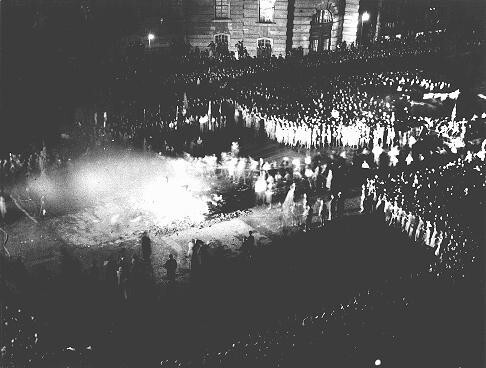
Book Burning May 10, 1933 Image courtesy US Holocaust Memorial Museum https://encyclopedia.ushmm.org/conten...
Can it happen here? It has.
Nearly a century before the Nazi book burnings, a concerted effort to flood the slaveholding states with abolitionist literature was met with fire. In the summer of 1835, an angry mob raided a Charleston, South Carolina post office and consigned thousands of abolitionist pamphlets to a bonfire. The book burning was topped off with an effigy of abolitionist William Lloyd Garrison being set ablaze. Garrison was lucky. Tragically, abolitionist publisher Elijah Lovejoy was not. Two years later, a mob intent on burning anti-slavery literature in Alton, Illinois murdered Lovejoy as he tried to defend his presses. A century later, in 1939, California growers burned Steinbeck’s Pulitzer Prize-winning The Grapes of Wrath.
Scrubbing the nation’s public square of “offensive” materials and torching books—despite the protections in the Bill of Rights—are as American as apple pie, lynch mobs, burning crosses, and now, tiki torches.
But there’s something new in the equation. The latest wave of book suppression is not simply about “subversion” or “dirty words.” Scratch the surface of recent book bans and it is clear that the assault on free expression cannot be separated from the larger Orwellian effort to sanitize American history, delegitimize literature by gay writers and people of color, and undermine democracy.
This revitalized onslaught carries the distinct whiff of white, Christian nationalism. This is the racial, cultural, and political ideology that once reared its head as nineteenth-century Nativism, the reinvigorated Ku Klux Klan of the 1920s, and the America Firsters of the 1930s.
Claiming that the United States is a “Christian nation,” this strand of anti-immigrant, anti-Catholic, and anti-Semitic American DNA is older than the nation itself. Time has not diminished its power. Now adding “globalists” to their enemies list, white Christian nationalism has been tied to the Charlottesville rioters who chanted “You will not replace us” and the January 6 insurrection by experts who study the movement.
America has no monopoly on this historically powerful faction. A form of white Christian nationalism, with its claims of racial superiority, certainly fed Hitler’s rise in Germany.
And that is why this revived wave of book suppression is a piece of a much larger development. The reason that Maus, a Pulitzer-Prize winning graphic novel-memoir about the Holocaust, was ostensibly pulled from schools in Tennessee was for some of its language and a discreet cartoon illustration of the author’s mother—an Auschwitz survivor—naked in the bathtub where she had committed suicide. But its critics apparently sought a kinder, gentler discussion of the Holocaust, although any attempts to soften that history tiptoe dangerously toward denialism. This is how history goes down 1984’s “Memory Hole.”
It is more than a little ironic that this onslaught of suppression comes as many on the Right decry the so-called “cancel culture” of the Left. Claiming their right to free speech is under attack, modern-day “book burners” crush that freedom under their boot heels as they attempt to distort or erase history and silence unwelcome voices. When such voices and ideas are deemed a threat and suppressed by the government, religious authorities, or a political party, we teeter on the thin ice of authoritarianism. The ice cracks when a fictional character is attacked—whether it is Homer Simpson, Huckleberry Finn, or Robin Hood. All three have come under fire over the years.
Banning books, legislating against “divisive concepts” in history class, and purging diversity all come straight from the playbook of the Strongman. He knows the power of the pen. Books make us think. Literature cultivates the free mind. Writers are truth-tellers. In 1917, Soviet leader Lenin ordered a “Decree on Press” threatening closure of publications critical of the Bolsheviks. Authoritarians know the danger posed by truth. And they are more than willing to use sword and flame to cut it down.
The question is what can we do about it?
“The antidote to authoritarianism is not some form of American authoritarianism,” Cooper Union librarian David K. Berninghausen told the Times in 1952. “The antidote is free inquiry.”
When Robin Hood was threatened by a textbook commissioner in 1953, some Indiana State University students fought back. Five of them gathered chicken feathers, dyed them green, and spread them across campus. Their protest caught on at other colleges, including UCLA, where two hundred students dressed up as Sherwood Forest’s Merry Men for a Green Feather drop. A clever, well-aimed protest, the Green Feather movement broke no windows or legs. Robin Hood was spared.
But those more innocent days are gone. In the internet age, the lines are more sharply drawn, sides set in stone, and the stakes much higher.
That is why dumping some green feathers or wearing an “I READ BANNED BOOKS” t-shirt will not be enough for this moment. If we care, we must take to heart Ike’s advice and “read every book.” We must firmly resolve to read. But buying and reading Maus or Toni Morrison’s Beloved are only the first steps.
We have to make sure that others can read these books. We must be audacious in support of free libraries and vigorously support all teachers who want to encourage students to read, debate, and think for themselves. And we must vigilantly push back on politicians and schoolboards purging libraries of uncomfortable truths. A few loud voices dominating a schoolboard or town hall meeting do not a majority make. To allow a noisy minority to dictate what we read and teach is skating on that thin ice of totalitarian loyalty oaths typical of a Mussolini or Stalin.
On this final note, history is clear. When you have succeeded in marking a writer as “degenerate” or “immoral”—as the Nazis did—you have moved towards dehumanizing them. It is a few short perilous steps from censorship to suppression to a conflagration far worse. In Berlin, on the spot where Nazis threw books into a bonfire, there is a plaque citing German playwright Heinrich Heine’s 1820 words, which read in part: “Where they burn books, they will ultimately burn people as well.”
The road to Hell is lit by burning books.
© Copyright 2022 Kenneth C. Davis All rights reserved
Don’t Know Much About Benedict Arnold and His Boot
(May 2022 update of a 2015 post)
Why is there a statue of Benedict Arnold’s boot?
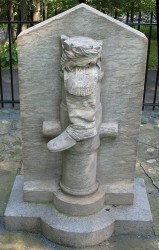
Statue of Benedict Arnold’s Boot at Saratoga National Historical Park
There it is — part of the Saratoga National Historical Park in Saratoga, New York. The “boot” is actually anonymous, citing the “most brilliant soldier in the Continental Army.”
On October 17, 1777, the British under General Burgoyne surrendered to American rebel troops led by Horatio Gates in one of the most significant turning points of the American Revolution.
But there is no question this marker honors American history’s greatest villain.
History books like to make people into heroes or villains. And Benedict Arnold was easily characterized as a villain, the most notorious traitor in American History for his attempt to betray the patriot cause when he was in command of the strategic post at West Point, overlooking the Hudson River. But he might have been one of the nation’s greatest heroes. And that is what makes history so compelling. Not the black and white of dates and “facts,” but the more subtle gray complexities of ego, ambition and human frailty.
Born on January 14, 1741 in colonial Norwich, Connecticut, Arnold had a biography that reads like that of a character out of Dickens. The son of a wealthy, successful ship’s captain and merchant, young Benedict Arnold was born with the proverbial silver spoon in his mouth. He was sent off to the best boarding school by his father, owner of the finest home in town. Then it fell apart. Yellow fever took his sisters while he was at school. Alcoholism then took his father. The fall was stunning as the elder Arnold became the town drunk and lost his fortune. At 14, young Benedict Arnold became an indentured servant. As a teenager, he ran away on several occasions to try and join the British-American forces then fighting France in the French and Indian War. Through pluck and generous relatives, Arnold eventually became a wealthy young merchant himself and was soon immersed in patriot politics, even traveling to Philadelphia to observe the First Continental Congress.
When the fighting began in 1775, he led Connecticut’s militia to Boston to join the rebel army gathering there. Arnold soon won honors for his role in the capture of Fort Ticonderoga on Lake Champlain on May 10, 1775. Cannons from Fort Ticonderoga were later taken to Boston by Henry Knox.
After Arnold’s treason, he was pretty much erased from this narrative and Ethan Allen worked hard to make sure he received complete credit. (Allen spent three years later as a British prisoner and even negotiated with the British for an independent Vermont. He later wrote a deist book attacking Christianity.)
With George Washington’s approval, Arnold went on to lead a daring but disastrous march through Maine to unsuccessfully attack Quebec.He was accompanied on that venture by a young Aaron Burr. History is constantly surprising and remarkable and often more intriguing than fiction.
Later, Arnold built a small navy to battle the British on Lake Champlain, helping save the patriot cause. But it was at Saratoga in October 1777 that he made his greatest contribution, leading a charge that turned the tide in what would become the most important American victory of the Revolution to that point.
During that charge, he was wounded in the leg and the injury caused a limp that would last his life. The statue recognizes Arnold’s wound and his central role in the victory at Saratoga without naming him.
Admired by Washington, Arnold also made a great many enemies. Seeing others promoted and advanced before him made him bitter and ultimately led to his fateful decision to join the British side.
After his plot was uncovered, Arnold did join the British side, fighting against his onetime countrymen. He led an assault on Virginia that nearly captured Governor Thomas Jefferson in 1781.
Arnold later moved to Canada and eventually to London where he died and was buried in June 1801 at the age of 60. His remains were accidentally –and fittingly?– moved to an unmarked grave.
You can read more about Arnold and his exploits in the chapter called “Arnold’s Boot” in America’s Hidden History and about the last day’s of the Revolution and Arnold’s role in The Hidden History of America at War.

America’s Hidden History, includes tales of “Forgotten Founders”

The Hidden History of America At War (paperback)
May 8, 2022
GREAT SHORT BOOKS: A Year of Reading–Briefly
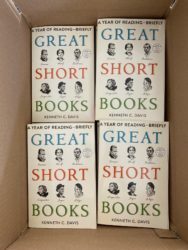
Bound galleys of Great Short Books have arrived!
COMING FROM SCRIBNER BOOKS
NOVEMBER 22, 2022
GREAT SHORT BOOKS:
A YEAR OF READING — BRIEFLY
During the lock-down, I swapped doom-scrolling for the insight and inspiration that come from reading great fiction. Inspired by Boccaccio’s “The Decameron” and its brief tales told during a pandemic, I read 58 great short novels –not as an escape but an antidote.
“A short novel is like a great first date. It can be extremely pleasant, even exciting, and memorable. Ideally, you leave wanting more. It can lead to greater possibilities. But there is no long-term commitment.”
–From “Notes of a Common Reader,” the Introduction to Great Short Books
The result is a compendium that goes from “Candide” to Colson Whitehead, and Edith Wharton to Leila Slimani. And yes, Maus and many other Banned Books and Writers.
Advance Praise for Great Short Books: A Year of Reading—Briefly
“GREAT SHORT BOOKS is a fascinating, thoughtful, and inspiring guide to a marvelous form of literature: the short novel. You can dip into this book anywhere you like, but I found myself reading it cover-to-cover, delighting in discovering new works while also revisiting many of my favorites. GREAT SHORT BOOKS is itself a great book—for those who are over-scheduled but want to expand their reading and for those who will simply delight in spending time with a passionate fellow reader who on every page reminds us why we need and love to read.”
–Will Schwalbe, New York Times bestselling author of THE END OF YOUR LIFE BOOK CLUB
“This is the book that you didn’t know you really needed. I began digging into this book as soon as I got it, and it was such a delight to read beautiful prose, just a sip at a time, with Kenneth Davis’ notes to give me context and help me more fully appreciate the stories. Keep this book near your bed or on your coffee table. It will be read and loved.”
–Celeste Headlee, journalist and author of WE NEED TO TALK and SPEAKING OF RACE
Available for pre-order from Scribner/Simon & Schuster
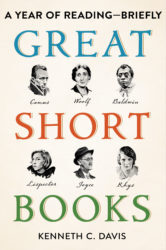
From hard-boiled fiction to magical realism, the 18th century to the present day, Great Short Books spans genres, cultures, countries, and time to present a diverse selection of acclaimed and canonical novels—plus a few bestsellers.
Like browsing in your favorite bookstore, this eclectic compendium is a fun and practical book for any passionate reader hoping to broaden their collection—or anyone who is looking for an entertaining, effortless reentry into reading.
I can’t wait to start talking about this book with readers everywhere.

A Year of Reading–Briefly
Don’t Know Much About® Harry S. Truman
Harry Truman, born on May 8, 1884, the 33rd President of the United States.
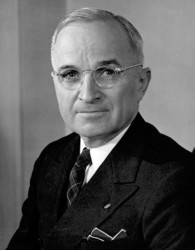
President Harry S. Truman
(Photo: Truman Library)
It was on his birthday in 1945 that Truman was able to tell Americans that the war in Europe was over with the surrender of Germany.
THIS IS a solemn but a glorious hour. I only wish that Franklin D. Roosevelt had lived to witness this day. General Eisenhower informs me that the forces of Germany have surrendered to the United Nations. The flags of freedom fly over all Europe. For this victory, we join in offering our thanks to the Providence which has guided and sustained us through the dark days of adversity.
Described as “a minor national figure with a pedestrian background,” Truman was a World War I veteran and a Senator from Missouri when Franklin D. Roosevelt chose him to become his running mate in the 1944 election. Truman became vice president when FDR won his fourth term and then took office on April 12, 1945 when FDR died.
When he took office, Truman had been largely left “out of the loop” by Roosevelt as World War II entered its final months. Truman did not know of the existence of the “Manhattan Project” and the development of the atomic bomb until he became president. Then he had to make the decision to use it against the Japanese.
Fast Facts
•Truman was a member of the Sons of the Revolution and the Sons of Confederate Veterans
•He wanted to attend West Point but poor eyesight kept him out. He enlisted in the Missouri National Guard and served as the commander of an artillery battery in World War I.
•Before entering politics, he was a farmer, bank clerk, insurance salesman and owner of a failed haberdashery store.
•As president he once threatened to punch the nose of a newspaper critic who had given his daughter a poor review after her debut singing recital. Margaret Truman went on to greater fame as a mystery novelist, beginning with Murder in the White House published in 1980.
•After Grover Cleveland, Truman is the only president who did not attend college. He attended law school briefly but dropped out.After the end of World War II, Truman had to shift America’s attention to the new “Cold War” with the Soviet Union and his policies of “containment” and the Marshall Plan to rebuild war-torn Europe were hallmarks of his presidency.Harry S. Truman died on December 26, 1972.
The Truman Library and Museum is located in Independence, Missouri
Read more about Truman, his life and administration in Don’t Know Much About® the American Presidents. Truman is also featured in the Berlin Battle chapter of The Hidden History of America at War.
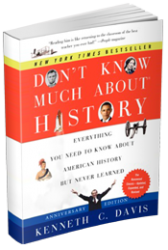
Don’t Know Much About History (Revised, Expanded and Updated Edition)

THE HIDDEN HISTORY OF AMERICA AT WAR: Untold Tales from Yorktown to Fallujah
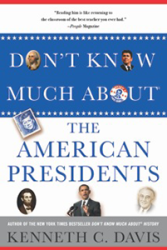
Don’t Know Much About® the American Presidents (Hyperion paperback-April 15, 2014)
May 6, 2022
Don’t Know Much About Memorial Day
LET’S SET THE RECORD STRAIGHT— Memorial Day is about Slavery
It is not about swimsuit sales, the start of summer, or the hot dogs on the barbie.
Memorial Day, the most solemn occasion on the national calendar, is about the Civil War, which was fought because of slavery, America’s original sin. Memorial Day is about a nation “conceived in liberty” but born in shackles.
In these fraught times, when teaching history has become so contentious, we must tell it straight when we observe the history behind the holiday. Here are some basic facts:
1) Memorial Day was born out of Decoration Day, first marked in May 30, 1868 by a proclamation of General John Logan, leader of a powerful Civil War veterans group. His original proclamation –“General Orders, No. 11”– read, in part: “Their soldier lives were the reveille of freedom to a race in chains and their deaths the tattoo of rebellious tyranny in arms.”
The day was an occasion for visiting the cemetery and decorating the graves of fallen Union soldiers who died in the Civil War.
2) The Civil War was fought over slavery. The “states rights” argument was put forward by “Lost Cause” apologists and eventually accepted by educators who wanted to diminish the significant role of slavery both in American history and in bringing about the war.
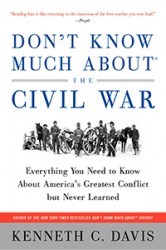
Don’t Know Much About the Civil War (Harper paperback, Random House Audio)
The truth matters. Now more than ever. So, once and for all, we must set the record straight.
As we observe Memorial Day, a day for honoring our nation’s war dead, let us emphasis these truths about America’s deep history of slavery.
Here are five important points that illustrate the through-line of slavery in American history, from the founding through the Civil War:
Enslaved people were in America before the Mayflower PilgrimsThomas Jefferson condemned slavery in drafting the Declaration of Independence but other Founders scrubbed the language from the nation’s “birth certificate”Slavery was “baked in” the U.S. Constitution in the three-fifths compromiseSlavery made the Civil War inevitableThe abolition of slavery after the Civil War did not end the stark divisions that continue to plague the United States todayREAD MORE in my article “Conceived in Liberty, Born in Shackles” (Social Education, March-April 2020)
I have also written about the divisive history of Memorial Day in an earlier post.
May 2, 2022
Who Said it

President Harry S. Truman
(Photo: Truman Library)
“This is a solemn but glorious hour. General Eisenhower informs me that the forces of Germany have surrendered to the United Nations. The flags of freedom fly all over Europe.”
–President Harry S. Truman, “The President’s Press Conference on V-E Day” (May 8, 1945)
Source: Harry S. Truman: “The President’s News Conference on V-E Day,” May 8, 1945. Online by Gerhard Peters and John T. Woolley, The American Presidency Project.
Read more about the Fall of Berlin and the end of World War II in THE HIDDEN HISTORY OF AMERICA AT WAR: Untold tales from Yorktown to Fallujah

The Hidden History of America At War (paperback)
May 1, 2022
STRONGMAN: The Rise of Five Dictators and the Fall of Democracy

Berlin 1945 Source: German Federal Archives-Public Domain https://commons.wikimedia.org/wiki/Fi... (Wikimedia Commons)
This comes one day after Hitler and his wife Eva Braun committed suicide in the Berlin bunker; Red Army troops were nearby and the Reich’s capital would soon fall to Stalin’s Soviet forces.On April 29, 1945, Hitler married Eva Braun in his bunker; US troops liberated prisoners from the Dachau concentration camp.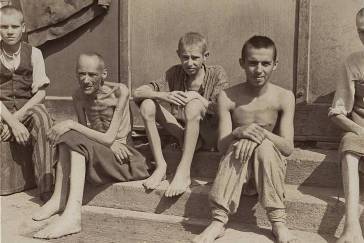
Survivors liberated at Dachau via US Holocaust Museum
https://www.ushmm.org/learn/timeline-...
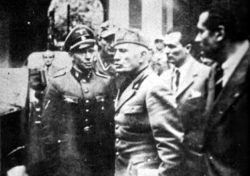
Benito Mussolini in Milan April 25, 1945-Last known photo of him alive (Public domain https://commons.wikimedia.org/wiki/Fi...)
STRONGMAN tells the real stories of the lives and times of five of the most deadly dictators of the 20th century — Mussolini, Hitler, Stalin, Mao Zedong, and Saddam Hussein.Order the hardcover and e-book from Holt BooksAn audiobook is available from Penguin Random House
Strongman named among Washington Post Best Children’s and Young Adult Books of 2020 Named to “Best Children’s Books of the Year-2021”
by the Bank Street College of EducationNamed to “Best Young Adult Books of the Year” by Kirkus ReviewsNamed to “Best YA Books of 2020 for Understanding the US Today” Kirkus ReviewsStarred review from Kirkus Reviews: “History’s warnings reverberate in this gripping read about five dictatorial strongmen. A pitch-perfect balance of nuanced reflection and dire warning.”Read the full review hereStarred Review from Publishers Weekly: “A fascinating, highly readable portrayal of infamous men that provides urgent lessons for democracy now.”Read the full review hereStarred Review from Shelf Awareness: “Kenneth C. Davis…conveys his plentiful knowledge of dictators in this powerful, spine-tingling biographic work that covers five of the world’s most horrifying autocrats. Grounded in thorough research, Strongman expertly explores the fragility of democracy …” Read the full review here
Named to “Best Children’s Books of the Year-2021”
by the Bank Street College of EducationNamed to “Best Young Adult Books of the Year” by Kirkus ReviewsNamed to “Best YA Books of 2020 for Understanding the US Today” Kirkus ReviewsStarred review from Kirkus Reviews: “History’s warnings reverberate in this gripping read about five dictatorial strongmen. A pitch-perfect balance of nuanced reflection and dire warning.”Read the full review hereStarred Review from Publishers Weekly: “A fascinating, highly readable portrayal of infamous men that provides urgent lessons for democracy now.”Read the full review hereStarred Review from Shelf Awareness: “Kenneth C. Davis…conveys his plentiful knowledge of dictators in this powerful, spine-tingling biographic work that covers five of the world’s most horrifying autocrats. Grounded in thorough research, Strongman expertly explores the fragility of democracy …” Read the full review here•2021 YALSA Nonfiction Award nominee
A review in Booklist says, “Davis does not sugarcoat his material, inviting long thoughts with his assertion that this is a decidedly human story that points to real people as evidence that evil exists in this troubled world.”
In addition to telling how these men took unlimited power, brought one-party rule to their nations, and were responsible for the deaths of millions of people, the book offers a brief history of Democracy and discusses the present threat to democratic institutions around the world.
In a time when Democracy is under assault across the globe, it is more important than ever to understand how a Strongman takes power and how quickly democracy can vanish –even as millions cheer its death.
ADVANCE PRAISE FOR STRONGMAN
“I found myself engrossed in it from beginning to end. I could not help admiring Davis’s ability to explain complex ideas in readable prose that never once discounted the intelligence of young readers. It is very much a book for our time.”
—Sam Wineburg, Margaret Jacks Professor of Education & History, Stanford University, author of Why Learn History (When It’s Already on Your Phone).
“Strongman is a book that is both deeply researched and deeply felt, both an alarming warning and a galvanizing call to action, both daunting and necessary to read and discuss.”
—Cynthia Levinson, author of Fault Lines in the Constitution: The Framers, Their Fights, and the Flaws That Affect Us Today
“A wake-up call to democracies like ours: we are not immune to despots . . . Strongman demonstrates that democracy is not permanent, unless it is collectively upheld. This book shakes that immortality narrative.”
—Jessica Ellison, President of the Minnesota Council for the Social Studies; Teacher Education Specialist, Minnesota Historical Society
Rarely does a history book take such an unflinching look at our common future, where the very presence of democracy is less than certain; even rarer is a history book in which the author’s moral convictions incite young readers to civic engagement; rarest of all, a history book as urgent, as impassioned, and as timely as Kenneth C. Davis’ Strongman.
—Eugene Yelchin, author of the Newbery Honor book Breaking Stalin’s Nose.
April 28, 2022
Who Said It? 10/28/2021
President Dwight D. Eisenhower (June 14, 1953)

President Eisenhower (Courtesy: Eisenhower Presidential Library and Museum)
In 1953, Senator Joseph McCarthy, with assistance from FBI Director J. Edgar Hoover, campaigned to suppress books hinting at any connection to Socialism or Communism.
In April 1953, two of McCarthy’s underlings, Roy Cohn and David Schine, were dispatched to Europe, partly to scour U.S. Information Service libraries. Created to provide war-ravaged countries with American books, these collections – McCarthy claimed – held thousands of works by Communists. Intimidated by McCarthy’s men, foreign service officials removed titles by, among others, the blacklisted writers Dashiell Hammett, Lillian Hellman, and Howard Fast.
Reluctant to challenge the powerful Senator, Eisenhower offered these words to a commencement audience at Dartmouth:
Look at your country. Here is a country of which we are proud, as you are proud of Dartmouth and all about you, and the families to which you belong. But this country is a long way from perfection–a long way. We have the disgrace of racial discrimination, or we have prejudice against people because of their religion. We have crime on the docks. We have not had the courage to uproot these things, although we know they are wrong. And we with our standards, the standards given us at places like Dartmouth, we know they are wrong.
Now, that courage is not going to be satisfied–your sense of satisfaction is not going to be satisfied, if you haven’t the courage to look at these things and do your best to help correct them, because that is the contribution you shall make to this beloved country in your time. Each of us, as he passes along, should strive to add something.
It is not enough merely to say I love America, and to salute the flag and take off your hat as it goes by, and to help sing the Star Spangled Banner. Wonderful! We love to do them, and our hearts swell with pride, because those who went before you worked to give to us today, standing here, this pride.
And this is a pride in an institution that we think has brought great happiness, and we know has brought great contentment and freedom of soul to many people. But it is not yet done. You must add to it.
Don’t join the book burners. Don’t think you are going to conceal faults by concealing evidence that they ever existed. Don’t be afraid to go in your library and read every book, as long as that document does not offend our own ideas of decency. That should be the only censorship.
“Remarks at the Dartmouth College Commencement Exercises”
Source and complete text: Dwight D. Eisenhower, Remarks at the Dartmouth College Commencement Exercises, Hanover, New Hampshire. Online by Gerhard Peters and John T. Woolley, The American Presidency Project
It is also worth noting that Eisenhower’s words did not translate into much action. U.S. Information Services libraries were stripped of thousands of titles.
STRONGMAN: The Rise of Five Dictators and the Fall of Democracy
At the same time, the Soviet Red Army was hammering Berlin in the final days of Hitler’s Third Reich.
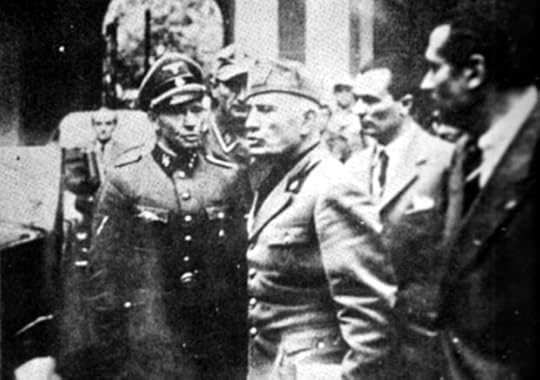
Benito Mussolini in Milan April 25, 1945-Last known photo of him alive (Public domain https://commons.wikimedia.org/wiki/Fi...)
STRONGMAN tells the real stories of the lives and times of five of the most deadly dictators of the 20th century — Mussolini, Hitler, Stalin, Mao Zedong, and Saddam Hussein.Order the hardcover and e-book from Holt BooksAn audiobook is available from Penguin Random House
Strongman named among Washington Post Best Children’s and Young Adult Books of 2020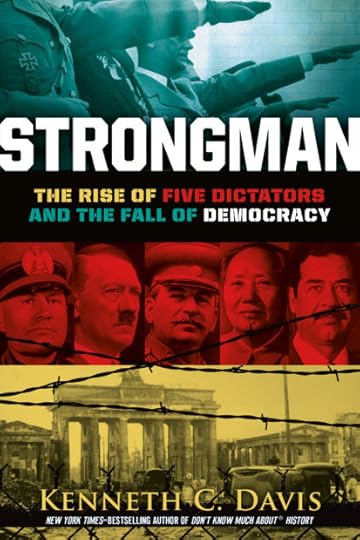 Named to “Best Children’s Books of the Year-2021”
by the Bank Street College of EducationNamed to “Best Young Adult Books of the Year” by Kirkus ReviewsNamed to “Best YA Books of 2020 for Understanding the US Today” Kirkus ReviewsStarred review from Kirkus Reviews: “History’s warnings reverberate in this gripping read about five dictatorial strongmen. A pitch-perfect balance of nuanced reflection and dire warning.”Read the full review hereStarred Review from Publishers Weekly: “A fascinating, highly readable portrayal of infamous men that provides urgent lessons for democracy now.”Read the full review hereStarred Review from Shelf Awareness: “Kenneth C. Davis…conveys his plentiful knowledge of dictators in this powerful, spine-tingling biographic work that covers five of the world’s most horrifying autocrats. Grounded in thorough research, Strongman expertly explores the fragility of democracy …” Read the full review here
Named to “Best Children’s Books of the Year-2021”
by the Bank Street College of EducationNamed to “Best Young Adult Books of the Year” by Kirkus ReviewsNamed to “Best YA Books of 2020 for Understanding the US Today” Kirkus ReviewsStarred review from Kirkus Reviews: “History’s warnings reverberate in this gripping read about five dictatorial strongmen. A pitch-perfect balance of nuanced reflection and dire warning.”Read the full review hereStarred Review from Publishers Weekly: “A fascinating, highly readable portrayal of infamous men that provides urgent lessons for democracy now.”Read the full review hereStarred Review from Shelf Awareness: “Kenneth C. Davis…conveys his plentiful knowledge of dictators in this powerful, spine-tingling biographic work that covers five of the world’s most horrifying autocrats. Grounded in thorough research, Strongman expertly explores the fragility of democracy …” Read the full review here•2021 YALSA Nonfiction Award nominee
A review in Booklist says, “Davis does not sugarcoat his material, inviting long thoughts with his assertion that this is a decidedly human story that points to real people as evidence that evil exists in this troubled world.”
In addition to telling how these men took unlimited power, brought one-party rule to their nations, and were responsible for the deaths of millions of people, the book offers a brief history of Democracy and discusses the present threat to democratic institutions around the world.
In a time when Democracy is under assault across the globe, it is more important than ever to understand how a Strongman takes power and how quickly democracy can vanish –even as millions cheer its death.
ADVANCE PRAISE FOR STRONGMAN
“I found myself engrossed in it from beginning to end. I could not help admiring Davis’s ability to explain complex ideas in readable prose that never once discounted the intelligence of young readers. It is very much a book for our time.”
—Sam Wineburg, Margaret Jacks Professor of Education & History, Stanford University, author of Why Learn History (When It’s Already on Your Phone).
“Strongman is a book that is both deeply researched and deeply felt, both an alarming warning and a galvanizing call to action, both daunting and necessary to read and discuss.”
—Cynthia Levinson, author of Fault Lines in the Constitution: The Framers, Their Fights, and the Flaws That Affect Us Today
“A wake-up call to democracies like ours: we are not immune to despots . . . Strongman demonstrates that democracy is not permanent, unless it is collectively upheld. This book shakes that immortality narrative.”
—Jessica Ellison, President of the Minnesota Council for the Social Studies; Teacher Education Specialist, Minnesota Historical Society
Rarely does a history book take such an unflinching look at our common future, where the very presence of democracy is less than certain; even rarer is a history book in which the author’s moral convictions incite young readers to civic engagement; rarest of all, a history book as urgent, as impassioned, and as timely as Kenneth C. Davis’ Strongman.
—Eugene Yelchin, author of the Newbery Honor book Breaking Stalin’s Nose.
April 27, 2022
Who Said it?
President Ulysses S. Grant
Sixth Annual Message to the Congress, December 7, 1874
I regret to say that with preparations for the late election decided indications appeared in some localities in the Southern States of a determination, by acts of violence and intimidation, to deprive citizens of the freedom of the ballot because of their political opinions. Bands of men, masked and armed, made their appearance; White Leagues and other societies were formed; large quantities of arms and ammunition were imported and distributed to these organizations; military drills, with menacing demonstrations, were held, and with all these murders enough were committed to spread terror among those whose political action was to be suppressed, if possible, by these intolerant and criminal proceedings. In some places colored laborers were compelled to vote according to the wishes of their employers, under threats of discharge if they acted otherwise; and there are too many instances in which, when these threats were disregarded, they were remorselessly executed by those who made them….
Under existing conditions the negro votes the Republican ticket because he knows his friends are of that party. Many a good citizen votes the opposite, not because he agrees with the great principles of state which separate parties, but because, generally, he is opposed to negro rule. This is a most delusive cry. Treat the negro as a citizen and a voter, as he is and must remain, and soon parties will be divided, not on the color line, but on principle. Then we shall have no complaint of sectional interference.
–Source: Ulysses S. Grant, Sixth Annual Message Online by Gerhard Peters and John T. Woolley, The American Presidency Project https://www.presidency.ucsb.edu/node/...
Read more about Grant in this post: “Don’t Know Much About U.S. Grant”



